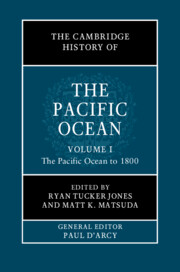Book contents
- The Cambridge History of the Pacific Ocean
- The Cambridge History of the Pacific Ocean
- The Cambridge History of the Pacific Ocean
- Copyright page
- Contents
- Figures
- Tables
- Contributors to Volume I
- Frontispiece
- General Editor’s Introduction
- Preface to Volume I
- Part I Rethinking the Pacific
- Part II Humans and the Natural World in the Pacific Ocean
- Part III Deep Time: Sources for the Ancient History of the Pacific
- Part IV The Initial Colonization of the Pacific
- 16 Pleistocene Voyaging and Maritime Dispersals in the Pacific
- 17 Early Maritime Navigation and Cultures in Coastal Southern China, Taiwan, and Island Southeast Asia, 6000–500 BCE
- 18 New Guinea’s Past: The Last 50,000 Years
- 19 Austronesian Colonization of the Pacific Islands, 1200 bce–1250 ce
- 20 Seafaring and Colonization in the Southern Ocean, 1000 ce–1850 ce
- 21 Polynesians in Central-South Chile
- Part V The Evolution of Pacific Communities
- Part VI Europe’s Maritime Expansion into the Pacific
- References to Volume I
- Index
19 - Austronesian Colonization of the Pacific Islands, 1200 bce–1250 ce
from Part IV - The Initial Colonization of the Pacific
Published online by Cambridge University Press: 11 November 2022
- The Cambridge History of the Pacific Ocean
- The Cambridge History of the Pacific Ocean
- The Cambridge History of the Pacific Ocean
- Copyright page
- Contents
- Figures
- Tables
- Contributors to Volume I
- Frontispiece
- General Editor’s Introduction
- Preface to Volume I
- Part I Rethinking the Pacific
- Part II Humans and the Natural World in the Pacific Ocean
- Part III Deep Time: Sources for the Ancient History of the Pacific
- Part IV The Initial Colonization of the Pacific
- 16 Pleistocene Voyaging and Maritime Dispersals in the Pacific
- 17 Early Maritime Navigation and Cultures in Coastal Southern China, Taiwan, and Island Southeast Asia, 6000–500 BCE
- 18 New Guinea’s Past: The Last 50,000 Years
- 19 Austronesian Colonization of the Pacific Islands, 1200 bce–1250 ce
- 20 Seafaring and Colonization in the Southern Ocean, 1000 ce–1850 ce
- 21 Polynesians in Central-South Chile
- Part V The Evolution of Pacific Communities
- Part VI Europe’s Maritime Expansion into the Pacific
- References to Volume I
- Index
Summary
The Austronesian language family comprises over 1,000 languages and has a history that stretches over six millennia. It is large and internally complex, but it was also the most widespread of all language families prior to European colonial expansion from the seventeenth century.1 The spread extends from Taiwan in the north, through island Southeast Asia and to as far south as New Zealand, Madagascar to the west and Rapa Nui in the east. For Oceania these language speakers were the key to the exploration, discovery, and colonization of most of the region. They first appear in the archaeological record at around 3,000 years ago in island Melanesia and Micronesia. In both regions they move out beyond a barrier of human settlement that had remained for more than 35,000 years to begin one of humanity’s great chapters of exploration and adaptation. Over a 2,400-year period the descendants of the pioneering explorers managed to find and settle almost every land mass across this vast region. They encountered radically different environmental situations, from large islands and associated archipelagoes with luxuriant biota to some of the most isolated, impoverished land masses found anywhere on the globe. Traversing sometimes vast areas of open sea in often turbulent oceans they managed to discover and establish, with transported crops and animals, sustainable communities on these new landscapes that have continued to refine their adaptation to specific regions and situations. This chapter traces this extraordinary journey through a rich archaeological record that has been built up over more than 100 years.
- Type
- Chapter
- Information
- The Cambridge History of the Pacific Ocean , pp. 434 - 456Publisher: Cambridge University PressPrint publication year: 2023



